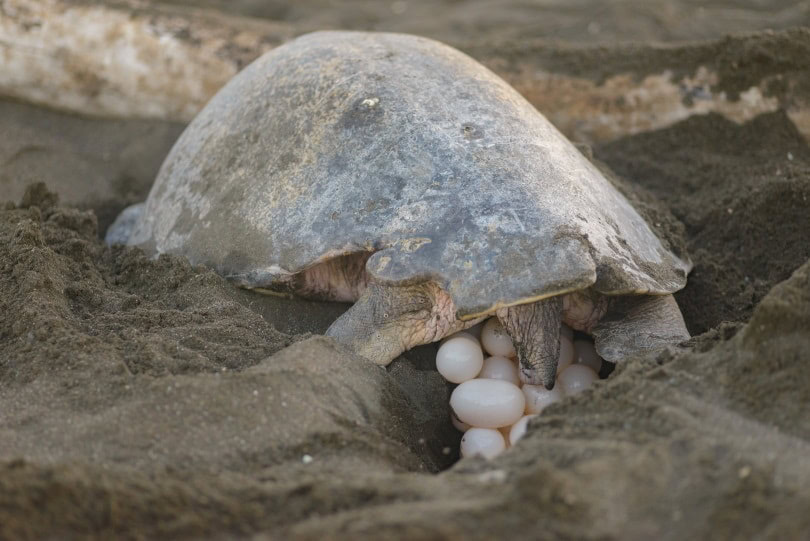Turtles can be a lot of fun to keep as pets, and they can be fun to watch if you have a small pond or a stream on your property where they live naturally. One of the most common questions is how many babies turtles have and how many eggs they lay. The answer depends on what type of turtle it is, but the number of offspring is usually pretty low. If you would like to learn more about these fascinating animals, keep reading while we look at several types of turtles to see how many eggs they lay and how many eggs hatch to help you be better informed.

How Many Babies Do Turtles Have?
Bog Turtles

- Bog Turtles are critically endangered species found in small areas of the northeastern United States, like Pennsylvania and New Jersey. They are the smallest species of turtle in America and rarely grow larger than 4 inches. Their heads are dark brown or black, and there is a bright orange, red, or yellow spot on each side of the neck.
- They typically lay one to six eggs, with the average being three. Older bog turtles lay more eggs than younger turtles. The eggs must incubate for 42–80 days, and during this time, they are extremely vulnerable to predators, and flooding and other bad weather can also destroy them.
Musk Turtles

- You might hear people call the Musk Turtle a Stinkpot, which is its common name. These small turtles usually grow to about 5.5 inches and are found on the east coast of the United States and parts of Canada. They have a pointed snout with a sharp beak and yellow lines on the neck. They usually lay between two and nine eggs and have a long incubation period of 100–150 days. Unfortunately, the eggs only have a hatch expectancy of 15%.
Painted Turtle

- The Painted Turtle is one of the easiest-to-find-turtles in the United States. It’s common in the eastern United States and much of the north. It’s also a popular pet that you can find available from many breeders. Painted turtles can grow to about 10 inches long, and they have an olive to black shell and red or yellow stripes on their legs, neck, and tail. They can lay four to 12 eggs, and the western turtles tend to lay more eggs (7–12) than the ones in the east (4–5).
Slider Turtles

- You can find the Slider Turtle in the southeastern United States. It has an olive or dark brown shell, and some turtles may have yellow patterns and stripes. Sliders lay several more eggs than the turtles we’ve looked at so far, and you can expect between 10 and 30 eggs per clutch.
Snapping Turtle

- People don’t usually keep Snapping turtles as pets, but you can find them in many smaller bodies of water in the central and eastern United States. They spend much of their time in the water but tend to be less afraid of humans since they are at the top of their food chain. Snapping turtles lay a large number of eggs, and you can expect them to lay between 25 and 80 eggs that will need to incubate for 9–18 weeks.
Box Turtles

- Box turtles are another common turtle in the United States. You can find them almost anywhere except a few states in the northwest. They usually lay between one and seven eggs per clutch, and they are common pets. Box turtles are also the state reptile in four states, including North Carolina, Tennessee, Missouri, and Kansas.
Mud Turtles

- The Mud Turtle is an aquatic breed that lives throughout the United States, Mexico, Central America, and South America. It’s similar but slightly smaller than the Musk Turtle. They have between two and five eggs that incubate for 6 to 12 weeks.

How Many Eggs Does a Sea Turtle Lay, How Many of Them Survive?

Sea turtles are large turtles off the coast that spend their entire lives in the water. Unfortunately, the sea turtles you can find in American waters, like the loggerhead, green sea turtle, leatherback, and others, are all on the endangered or threatened list. They can be up to 5 feet long and usually lay about 100 eggs in the warm sand, which will need to incubate for about 60 days.
The turtles hatch in unison to overwhelm predators like wild dogs, foxes, raccoons, and more that might be waiting. These events are “turtle boils” because their movement resembles boiling water, and it helps to improve the survival rate.
Unfortunately, many experts agree that as few as one in 1,000 sea turtles will survive to reach maturity, which is part of the reason there are so few in American waters.
How Often Do Turtles Lay Eggs?
Most turtles lay eggs only once per year, but a few breeds may do so twice. The Keeled Box Turtle is one example of an American turtle that can give birth more than once yearly.

Summary: How Many Eggs Do Turtles Have
Most turtles produce about four to six eggs per clutch and lay them once or twice yearly in a hidden location like under a log or other debris. The downside is that many eggs have long incubation periods that expose them to multiple predators and weather events that can compromise the shell’s protection and reduce the number of expected babies.
We hope you have enjoyed reading this short guide and found the answers you need. If we have helped you understand these animals better, please share our look into how many babies turtles have on Facebook and Twitter.
Related reads:
Featured Image Credit: Elena Kouptsova, Shutterstock










